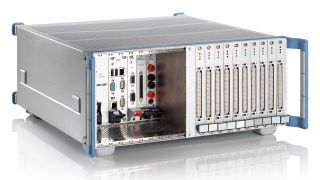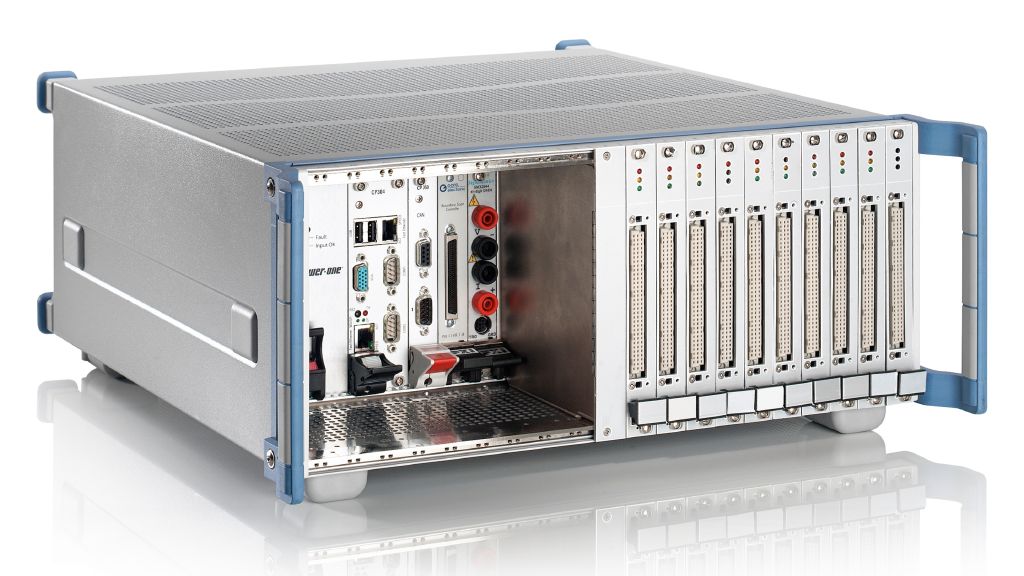Rohde & Schwarz solution
The PXI based R&S®CompactTSVP platform is an automated test system for functional and in-circuit testing in mass production. The R&S®CompactTSVP meets all of the previously mentioned requirements in a single test system. The internal signal bus concept in combination with internal multiple switch matrix cards (4 × 90 each) provides reliable, flexible and efficient signal routing between test and measurement instruments, switching relays and DUTs.
Expensive, less reliable external cabling is not required, which makes it much easier to keep track of the signal routing. The R&S®CompactTSVP has a rear I/O concept for connecting additional power supplies and loads. These power lines are routed via high-power switching cards to the fixture interfaces on the front of the instrument, which keeps the measurement setup simple.
A signal routing library with preconfigured and user-configurable signal routing models makes it easy to program complex signal connections between measurement modules and the DUT. Users can tailor the test system to their test plan and flexibly configure up to 14 measurement and switching modules.
A single-slot, dual-channel floating arbitrary waveform generator simulates sensor signals or generates clock or pulse signals for testing analog-to-digital-converters (ADC) and frequency-to-voltage converters (FU). The isolated outputs allow the direct generation of differential signals. On the actuator side, a single-slot, eight-channel floating signal analyzer monitors dynamic current consumption (pulses) via a shunt resistor. Floating inputs are mandatory to directly connect the shunt to extend the measurement range in order to achieve high current resolution.
The multimeter module (R&S®TS-PSAM) covers all voltage, current and resistance measurements for functional testing (FCT) and in-circuit testing (ICT). The internal bus system connects any current sensor on the switching cards with the R&S®TS-PSAM for current measurements.
Internal and external loads are connected to the individual control signals to test the ECU‘s actuator signals. High-current switching cards from 2 A up to 50 A with integrated current measurement capability route external loads from the rear of the R&S®CompactTSVP to the front, which makes the setup neat and efficient.
To ensure high reliability, the test system offers integrated self-test capability and in-system calibration routines. The self-test measures the contact resistances of all switching cards without any additional cabling or specific adaptation.
In-system calibration allows all measurement modules in the R&S®CompactTSVP chassis to be calibrated with an external multimeter.
The core of any test system is software that runs all required tests in production automatically. Thanks to the open software concept, all common programming languages such as C, C#, LabWindows/CVI and the test management software TestStand can be used for easy integration into existing test system software.
All software components such as the user interface for the installed R&S®CompactTSVP modules, the instrument drivers, self-test and in-system calibration, and ICT with debugger and automatic test generator are included in the R&S®GTSL generic test software library and do not require a software license.
The measurement modules for functional testing can be reused for ICT, delivering true investment cost savings. A specific version of the mass interconnect interface from Virginia Panel Corporation can be connected directly to the R&S®CompactTSVP chassis and modules without any interface cabling. This ensures highly reliable signal connections without degrading signal quality.
ECU testing with the R&S®CompactTSVP
R&S®CompactTSVP – modular and compact test solution for ICT, FCT and JTAG/boundary scan tests for automotive ECUs










